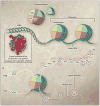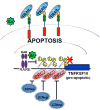The roles of retinoic acid and retinoic acid receptors in inducing epigenetic changes
- PMID: 24962884
- PMCID: PMC4199334
- DOI: 10.1007/978-94-017-9050-5_7
The roles of retinoic acid and retinoic acid receptors in inducing epigenetic changes
Abstract
Epigenetics is "the branch of biology which studies the causal interactions between genes and their products which bring the phenotype into being" as defined by Conrad Waddington in 1942 in a discussion of the mechanisms of cell differentiation. More than seven decades later we know that these mechanisms include histone tail post-translational modifications, DNA methylation, ATP-dependent chromatin remodeling, and non-coding RNA pathways. Epigenetic modifications are powerful drugs targets, and combined targeting of multiple pathways is expected to significantly advance cancer therapy.
Figures






Similar articles
-
Signals and combinatorial functions of histone modifications.Annu Rev Biochem. 2011;80:473-99. doi: 10.1146/annurev-biochem-061809-175347. Annu Rev Biochem. 2011. PMID: 21529160 Review.
-
Three-dimensional regulation of transcription.Protein Cell. 2015 Apr;6(4):241-53. doi: 10.1007/s13238-015-0135-7. Epub 2015 Feb 12. Protein Cell. 2015. PMID: 25670626 Free PMC article. Review.
-
Epigenetic regulation in human melanoma: past and future.Epigenetics. 2015;10(2):103-21. doi: 10.1080/15592294.2014.1003746. Epigenetics. 2015. PMID: 25587943 Free PMC article. Review.
-
Epigenetics: judge, jury and executioner of stem cell fate.Epigenetics. 2012 Aug;7(8):823-40. doi: 10.4161/epi.21141. Epub 2012 Jul 18. Epigenetics. 2012. PMID: 22805743 Free PMC article. Review.
-
Decoding liver injury: A regulatory role for histone modifications.Int J Biochem Cell Biol. 2015 Oct;67:188-93. doi: 10.1016/j.biocel.2015.03.009. Epub 2015 Mar 20. Int J Biochem Cell Biol. 2015. PMID: 25801055 Review.
Cited by
-
Epigenetic Cancer Therapy.Indian J Surg Oncol. 2024 Sep;15(3):447-450. doi: 10.1007/s13193-024-02067-w. Epub 2024 Aug 24. Indian J Surg Oncol. 2024. PMID: 39239429 Free PMC article. No abstract available.
-
Control of Innate and Adaptive Lymphocytes by the RAR-Retinoic Acid Axis.Immune Netw. 2018 Jan 18;18(1):e1. doi: 10.4110/in.2018.18.e1. eCollection 2018 Feb. Immune Netw. 2018. PMID: 29503736 Free PMC article. Review.
-
Role of retinoids in the prevention and treatment of colorectal cancer.World J Gastrointest Oncol. 2015 Oct 15;7(10):184-203. doi: 10.4251/wjgo.v7.i10.184. World J Gastrointest Oncol. 2015. PMID: 26483874 Free PMC article. Review.
-
The Mitochondrial Protein VDAC1 at the Crossroads of Cancer Cell Metabolism: The Epigenetic Link.Cancers (Basel). 2020 Apr 22;12(4):1031. doi: 10.3390/cancers12041031. Cancers (Basel). 2020. PMID: 32331482 Free PMC article.
-
Identification of Ethanol and 4-Nitroquinoline-1-Oxide Induced Epigenetic and Oxidative Stress Markers During Oral Cavity Carcinogenesis.Alcohol Clin Exp Res. 2015 Aug;39(8):1360-72. doi: 10.1111/acer.12772. Alcohol Clin Exp Res. 2015. PMID: 26207766 Free PMC article.
References
-
- Agger K, Cloos PA, Christensen J, Pasini D, Rose S, Rappsilber J, Issaeva I, Canaani E, Salcini AE, Helin K. UTX and JMJD3 are histone H3K27 demethylases involved in HOX gene regulation and development. Nature. 2007;449:731–734. - PubMed
-
- Bantscheff M, Hopf C, Savitski MM, Dittmann A, Grandi P, Michon AM, Schlegl J, Abraham Y, Becher I, Bergamini G, Boesche M, Delling M, Dumpelfeld B, Eberhard D, Huthmacher C, Mathieson T, Poeckel D, Reader V, Strunk K, Sweetman G, Kruse U, Neubauer G, Ramsden NG, Drewes G. Chemoproteomics profiling of HDAC inhibitors reveals selective targeting of HDAC complexes. Nat Biotechnol. 2011;29:255–265. - PubMed
-
- Béguelin W, Popovic R, Teater M, Jiang Y, Bunting KL, Rosen M, Shen H, Yang SN, Wang L, Ezponda T, Martinez-Garcia E, Zhang H, Zheng Y, Verma SK, McCabe MT, Ott HM, Van Aller GS, Kruger RG, Liu Y, McHugh CF, Scott DW, Chung YR, Kelleher N, Shaknovich R, Creasy CL, Gascoyne RD, Wong KK, Cerchietti L, Levine RL, Abdel-Wahab O, Licht JD, Elemento O, Melnick AM. EZH2 Is Required for Germinal Center Formation and Somatic EZH2 Mutations Promote Lymphoid Transformation. Cancer Cell. 2013;23:677–692. - PMC - PubMed
Publication types
MeSH terms
Substances
Grants and funding
LinkOut - more resources
Full Text Sources
Other Literature Sources

